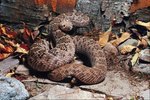
Variations on the saying “Red on yellow, kill a fellow; red on black, friend of Jack” refer to the colored bands found on some species of snakes. Learning the patterns of these markings—called rings or crossbands depending on how far they wrap around the snake—can help identify the animals and aid in personal safety. Common snakes with black and red bands include milksnakes, kingsnakes and coral snakes.
Kingsnakes
The scarlet kingsnake is a brilliantly colored, small snake species found in the Eastern and Southeastern regions of the United States. Rings cover its body, following a pattern of red, black, yellow, black. Its red bands do not touch its yellow bands, helping to indicate that it is a nonvenomous species. The California mountain kingsnake has a similar coloration and pattern, while other types of kingsnakes are primarily black or brown.
Milksnakes
The Eastern milksnake is found throughout Eastern and central North America and is a constrictor. Its black, red and white markings can resemble rings, but are often blotch- or saddle-shaped, and the red markings are darker than those of its relative the scarlet kingsnake. The pattern of markings follows the order white, black, red, black, with the red markings being the largest. As the rhyme suggests, red touches black, highlighting that this is a nonvenomous species.
Coral Snakes
The harmless scarlet kingsnake mimics the coloration of the dangerous Eastern coral snake, which is also red, black and yellow. Its pattern of colors helps identify the species and indicates that it is a venomous snake: black, yellow, red, yellow. The coral snake's range overlaps some of the scarlet kingsnake’s range in the southeast United States and extends into Mexico. Because of this overlap, the “Red on yellow, kill a fellow; red on black, friend of Jack” rhyme is helpful to those who might encounter either species. Though a bite from the coral snake can be deadly, this outcome is unlikely due in part to antivenin availability.
Other Banded Snakes
The coral snake is the only red-and-black-banded venomous snake in the United States, but other nonvenomous banded snakes can be found around the country. In California, for example, you can find ground snakes and other species with black bands, sometimes with reddish or orange accompanying markings. Corn snakes, found mostly in the Southeast, are orange or yellow with red, blotchy markings resembling bands and sometimes surrounded by a black border.
References
- Florida Museum of Natural History: Herpetology—Color Patterns and Scales Structure
- Savannah River Ecology Laboratory: Scarlet Kingsnake/Eastern Milksnake
- New Hampshire Fish and Game: Eastern Milk Snake
- CaliforniaHerps.com: Banded California Snakes
- National Geographic: Eastern Coral Snake
- Centers for Disease Control: Workplace Safety and Health Topics - Venomous Snakes
Resources
Photo Credits
-
Brand X Pictures/Brand X Pictures/Getty Images
Writer Bio
E. Anne Hunter has more than a decade of experience in education, with a focus on visual design and instructional technology. She holds a master's degree in education. Hunter has contributed to several professional publications, covering education, design, music and fitness, among other topics.




